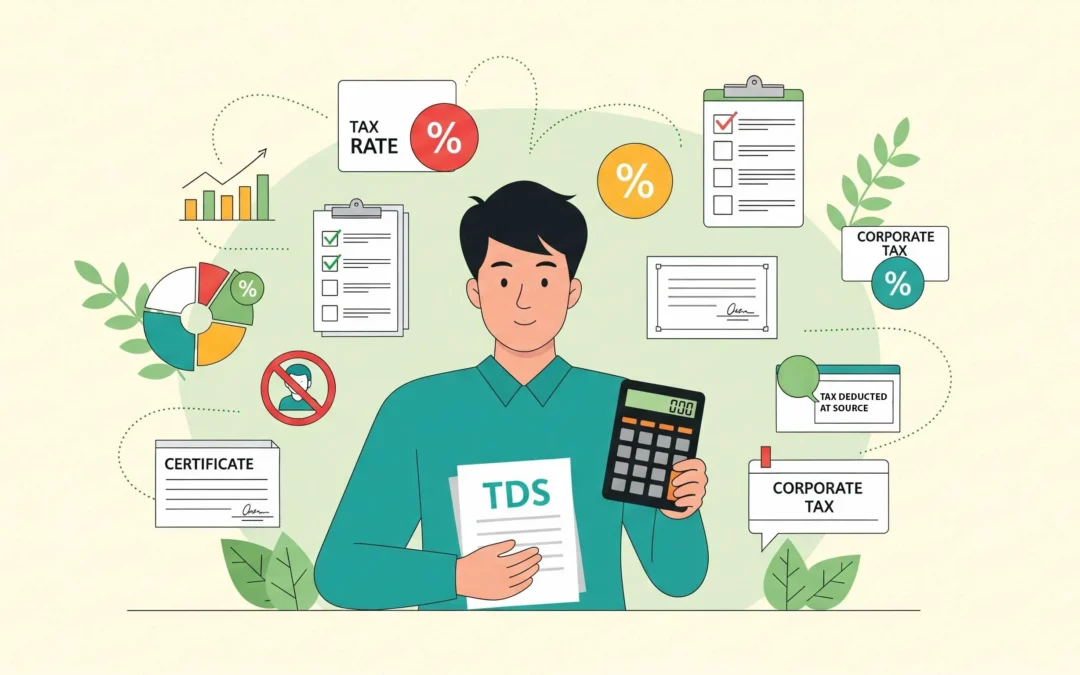Tax Deducted at Source (TDS) has recently become one of the most important compliance checkpoints after the rapid digitization of tax systems in India. The transactions must now be scanned for TDS under more strict provisions and lower rates no matter it is with the vendors, professionals, or contractors.
In the financial year 2025, the government has unveiled considerable changes in TDS rates, threshold limits, and filing obligations. Being aware of these reforms will assist in not only avoiding the payment of fines but will also help in establishing financial correctness and tax transparency throughout the business operations. This article will help you understand TDS rates and compliance changes for businesses.
Understanding TDS and Its Importance for Businesses
The government collects TDS, a type of advance tax, at the time of a transaction. It lowers tax evasion and guarantees a consistent flow of income. Companies deposit TDS with the Income Tax Department after deducting it from certain payments, such as rent, professional fees, interest, and salaries.
The Significance of TDS for Enterprises
- Guarantees adherence to the Income Tax Act.
- Reduces the burden of paying taxes at the end of the year.
- Increases trust with customers, suppliers, and authorities.
- Aids in avoiding penalties and interest.
TDS Rates for FY 2025-26
Although the majority of TDS rates have been maintained by the government, several transactions are now impacted by modifications to thresholds and digital reporting standards. An overview of the frequently used TDS rates for businesses can be found below:
| Nature of Payment | Section | Threshold (₹) | TDS Rate (%) |
| Salary | 192 | As per the income slab | Slab Rate |
| Interest other than securities | 194A | Rs. 1,00,000 for senior citizens and Rs. 50,000 for others | 10% |
| Contractor payments (individual/HUF) | 194C | ₹30,000/single or ₹1,00,000/annum | 1% |
| Contractor payments (others) | 194C | ₹1,00,000/annum | 2% |
| Rent (land/building/furniture) | 194I | ₹50,000 per month | 10% (land), 2% (plant/machinery) |
| Professional fees/technical service | 194J | ₹50,000 per year | 10% (Professional fees)2% (technical service) |
| Commission or brokerage | 194H | ₹20,000 per year | 2% |
| Purchase of goods | 194Q | ₹50,00,000 per year | 0.1% |
Key TDS Compliance Changes
The compliance framework around TDS has been made stricter in order to ensure that deductions are made on time, reporting is accurate, and there is digital transparency. The major changes which businesses have to keep in mind are given below.
1. Mandatory Electronic TDS Returns
- All businesses have been made mandatory to file the TDS returns for each quarter online. This rule is also applicable to proprietorships that are under audit.
- Remember to validate it through FVU (File Validation Utility) before loading it up.
2. Revised TDS Certificate Timelines
- Form 16 (for salary) should be given out no later than 15th June.
- Form 16A (in case of other TDS) should be given out at most 15 days after the quarterly return has been filed.
3. New TDS Section 194M and 194N Enforcement
- Section 194M: Individuals or HUFs not liable to audit must deduct TDS at 2% for contractual/professional payments above ₹50 lakh in a financial year.
- TDS of 2% will be applicable for cash withdrawals exceeding ₹1 crore from one bank during a financial year. In case of default, where an ITR is not filed for 3 years, then withdrawing Rs. 20 lakhs charges an extra 5%.
4. AIS and PAN Integration for Real-Time Verification
Through the integration of TDS data with the Annual Information Statement (AIS) and PAN verification tools, the Income Tax Department has improved its digital ecosystem. This modification has an impact on the reporting and verification of TDS transactions:
- Transparency has improved as all TDS deductions now appear in the payee’s AIS faster.
- When PAN, TDS returns, and payment information don’t match, automated red flags may be raised.
- Only when returns are properly filed and PANs are verified will TDS credits be automatically added to the ITR forms.
Ensuring TDS Compliance: Best Practices for Businesses
To handle TDS correctly and free from legal problems, businesses must adopt the following practices for their day-to-day operations:
- Automate TDS deductions: Employ an accounting software that notifies you of the eligible transactions and also calculates the TDS automatically.
- Track PAN and threshold limits: Get PAN from payees always, and keep an eye on payment thresholds.
- Regular reconciliation: Ensure that the TDS entries you have in your books are the same as those in Form 26AS and the TRACES portal.
- Train finance teams: Give accounting staff up-to-date training on TDS provisions and reporting deadlines.
- Timely deposits and filings: Make sure that TDS is deposited by the 7th of the next month and returns are filed before the due dates.
Bottomline
The conclusion can be drawn that knowing TDS can guarantee the smooth operation of business and avoid troubles in the form of penalties and fines. It is important to keep themselves updated on the most recent TDS rate changes, paperwork, and e-filing requirements.
Compliance on time, correct deductions, and filing at the right moment are by now non-negotiables to be trusted, to be free from sanctions, and to develop with a long-term mindset. Understanding it may be difficult, and hence, this article will help to know the basics.


